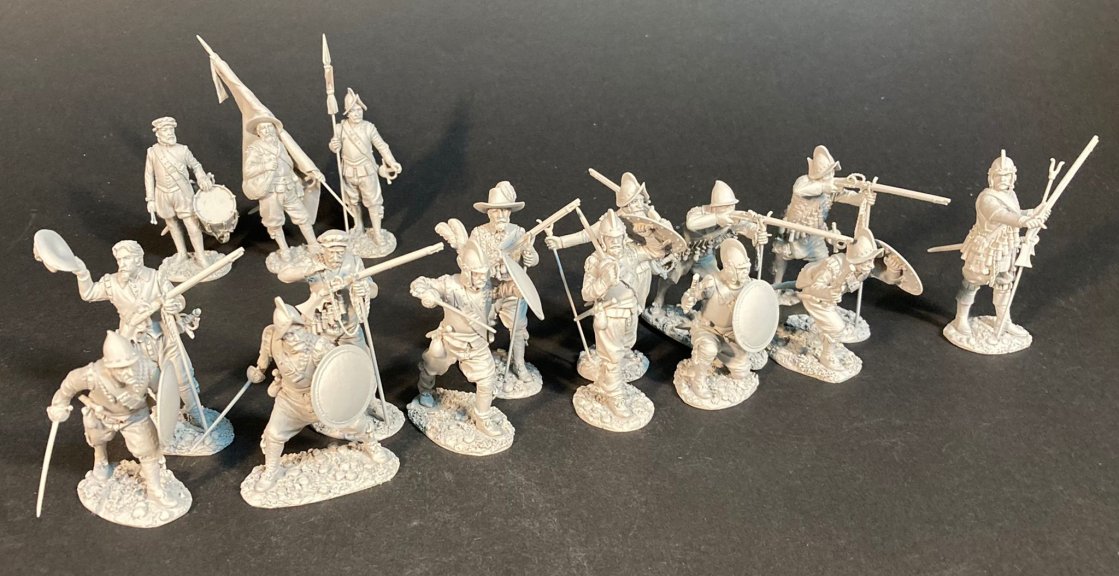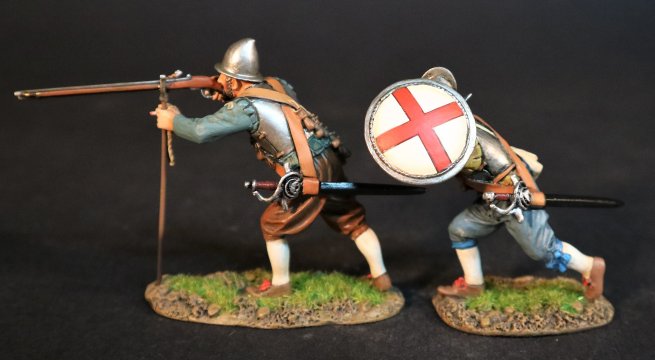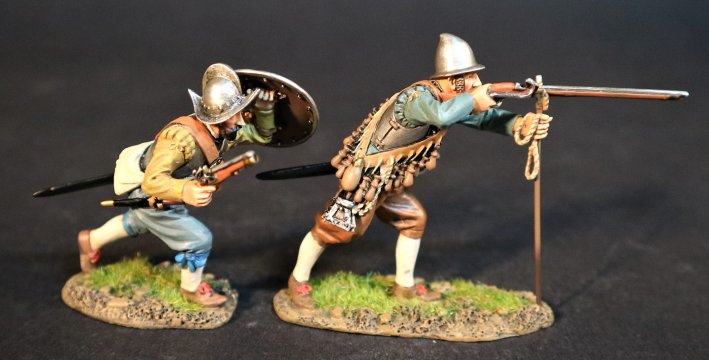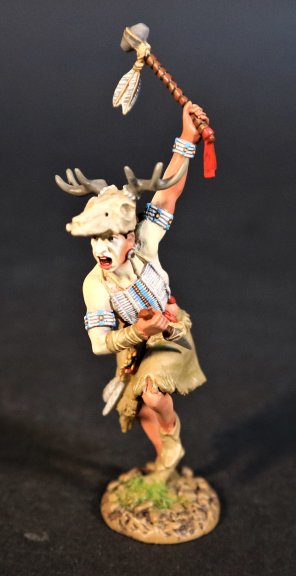- Joined
- Feb 2, 2011
- Messages
- 2,093
NEW RELEASES FOR JANUARY 2023
THE CONQUEST OF AMERICA
THE JAMESTOWN SETTLEMENT
THE ANGLO-POWHATAN WARS
Spain, Portugal, and France moved quickly to establish a presence in the New World. The English did not attempt to establish colonies until many decades after their explorations of John Cabot, with early efforts proving to be failures, most notably the Roanoke Colony which vanished around 1590.

The Jamestown settlement in the colony of Virginia was the first permanent English settlement in the Americas. It was located on the northwest bank of the James (powhatan) river, about 2 ½ miles southwest of the centre of modern Williamsburg.
It was established by the Virginia Company of London, as James Fort on May 4[SUP]th[/SUP] 1607.
The Anglo-Powhatan Wars were three conflicts fought between settlers of the Virginia Colony and Algonquin Indians of the Powhatan Confederacy in the early seventeenth Century.
The first war started in 1609 and ended in a peace settlement in 1614.
After several years of strained co-existence, Chief Opechancanough and his Powhatan Confederacy attempted to eliminate the English colony. This was the start of the second war which was to last from 1622 to 1626.
On the morning of March 22, 1622, the confederacy attacked outlying plantations and communities along the James River in what became known as the Indian Massacre of 1622.
More than 300 settlers were killed in the attack, which was about a third of the colony’s English speaking population.
Jamestown was spared only through a timely warning by a Virginia Indian employee.
Powhatan war practice was to wait and see what would happen after inflicting such a blow, in hopes that the settlement would simply abandon their homeland and move on elsewhere.
However, English military doctrine called for a strong response, and the colonial militia marched out nearly every summer for the next 10 years and made assaults on Powhatan settlements.
Opechancanough was to sue for peace in 1623.
The war lasted until Samuel Argall captured Wahunsenacawh’s daughter Matoaka, better known by her nickname Pocahontas, after which the chief accepted a treaty of peace.
The third war lasted from 1644 until 1646 and ended when Opechancanough was captured and killed. The war resulted in a defined boundary between the Indians and colonial lands that could only be crossed for official business with a special pass.
This situation lasted until 1677 and the Treaty of Middle Plantation which established Indian Reservations following Bacon’s Rebellion.

JT-04
THE CONQUEST OF AMERICA,
THE JAMESTOWN SETTLEMENT,
THE ANGLO-POWHATAN WARS
VIRGINIA MILITIA.
(2 pcs)

SKRAELINGS, THE BEOTHUK
SKRAELING is the name the Norse Greenlanders used for the peoples they encountered in North America, and Greenland.
In the Viking Sagas, it is also used for the peoples of the region known as Vinland whom the Norse encountered during their expeditions there in the early 11[SUP]th[/SUP] Century.

SK-06
THE CONQUEST OF AMERICA,
SKRAELINGS,
BEOTHUK WARRIOR.
(1 pc)
The word Skraeling is most likely related to the old Norse word “skra”, meaning “dried skin”, which is believed to be in reference to the animal pelts worn by the native Americans.
The term is thought to have been first used by Ari Thorgilsson in his work called “The Book Of The Icelanders”. The book was written well after the period in which Norse explorers made their first contacts with indigenous Americans. By the time of the book, Skraeling was probably the common term Norse Greenlanders used for the Thule people, who were the ancestors of the modern Inuit.
The Greenlander’s Saga and the Sago of Erik the Red, which were written in the 13[SUP]th[/SUP] Century, use this term for the people of the area known as Vinland whom the Norse met in the early 11[SUP]th[/SUP] Century. The word has subsequently become well known and has been used in the English language since the 18[SUP]th[/SUP] Century.
Probably the most likely local inhabitants of the area named as Vinland were the Beothuk, or at least their ancestors. The meaning of the word Beothuk is obscure, but “people” or “good people” are possibilities. They lived in villages made up of a number of cone-shaped houses called “Mamateeks”.
Unfortunately the Beothuk have since vanished, with the last of their tribe believed to have died in the 19[SUP]th[/SUP] Century.
Ethnologists have recognized what are at least similarities between the Beothuk peoples and other still existing tribes native to North America, like the Algonquin Indians. This helps give us some insight into the Beothuk, their weapons and the way in which they lived.
There was a vast difference in the weapons possessed by the Beothuk and those available to the Vikings. The most significant variation was the ability of the Vikings to smelt iron in order to create high quality swords and axes, along with iron tipped spears and arrows.
The Beothuk were in awe and fear of these iron weapons. In one saga it tells of “One of the Skraelings had picked up an axe, and after examining it for a moment, he swung it at a man standing beside him, who fell dead at once”.
The vikings had nothing good to say about the people they met. They referred to these people as poor traders, primitive people who were easily scared.
Norse exploration of the new world began with the initial sighting of North America by an Icelander named Bjarni Herjolfsson, who spotted land after drifting off course on a journey to Greenland in 985.
They speculated amongst themselves as to what land this might be, for Bjarni said he suspected this was not Greenland.
His voyage piqued the interest of later explorers including Leif Eriksson, who would explore and name the areas of Helluland, Markland and Vinland.
Eriksson laid the groundwork for later colonizing efforts in the generations to come by establishing a foothold on Vinland, when he constructed some "large houses."
There was great discussion of Leif's Vinland voyage, and his brother Thorvald felt they had not explored enough of the land. Leif then told Thorvald, 'You go to Vinland, brother, and take my ship if you wish, but before you do so I want the ship to make a trip to the skerry to fetch the wood that Thorir had there.”
Thorvald has the first contact with the native population which would come to be known as the Skraelings. After capturing and killing eight of the natives, they were attacked at their beached ships, which they defended.
'I have been wounded under my arm,' he said. 'An arrow flew between the edge of the ship and the shield into my armpit. Here is the arrow, and this wound will cause my death.
After this adventure, they returned to Greenland. Their three-year excursion would be the longest lasting known European colony in the New World until Columbus’s voyages nearly 500 years later initiated full-scale European conquest of the Americas.
** PLEASE CONTACT YOUR LOCAL DEALER FOR FURTHER INFORMATION **
THE CONQUEST OF AMERICA
THE JAMESTOWN SETTLEMENT
THE ANGLO-POWHATAN WARS
Spain, Portugal, and France moved quickly to establish a presence in the New World. The English did not attempt to establish colonies until many decades after their explorations of John Cabot, with early efforts proving to be failures, most notably the Roanoke Colony which vanished around 1590.

The Jamestown settlement in the colony of Virginia was the first permanent English settlement in the Americas. It was located on the northwest bank of the James (powhatan) river, about 2 ½ miles southwest of the centre of modern Williamsburg.
It was established by the Virginia Company of London, as James Fort on May 4[SUP]th[/SUP] 1607.
The Anglo-Powhatan Wars were three conflicts fought between settlers of the Virginia Colony and Algonquin Indians of the Powhatan Confederacy in the early seventeenth Century.
The first war started in 1609 and ended in a peace settlement in 1614.
After several years of strained co-existence, Chief Opechancanough and his Powhatan Confederacy attempted to eliminate the English colony. This was the start of the second war which was to last from 1622 to 1626.
On the morning of March 22, 1622, the confederacy attacked outlying plantations and communities along the James River in what became known as the Indian Massacre of 1622.
More than 300 settlers were killed in the attack, which was about a third of the colony’s English speaking population.
Jamestown was spared only through a timely warning by a Virginia Indian employee.
Powhatan war practice was to wait and see what would happen after inflicting such a blow, in hopes that the settlement would simply abandon their homeland and move on elsewhere.
However, English military doctrine called for a strong response, and the colonial militia marched out nearly every summer for the next 10 years and made assaults on Powhatan settlements.
Opechancanough was to sue for peace in 1623.
The war lasted until Samuel Argall captured Wahunsenacawh’s daughter Matoaka, better known by her nickname Pocahontas, after which the chief accepted a treaty of peace.
The third war lasted from 1644 until 1646 and ended when Opechancanough was captured and killed. The war resulted in a defined boundary between the Indians and colonial lands that could only be crossed for official business with a special pass.
This situation lasted until 1677 and the Treaty of Middle Plantation which established Indian Reservations following Bacon’s Rebellion.

JT-04
THE CONQUEST OF AMERICA,
THE JAMESTOWN SETTLEMENT,
THE ANGLO-POWHATAN WARS
VIRGINIA MILITIA.
(2 pcs)

SKRAELINGS, THE BEOTHUK
SKRAELING is the name the Norse Greenlanders used for the peoples they encountered in North America, and Greenland.
In the Viking Sagas, it is also used for the peoples of the region known as Vinland whom the Norse encountered during their expeditions there in the early 11[SUP]th[/SUP] Century.

SK-06
THE CONQUEST OF AMERICA,
SKRAELINGS,
BEOTHUK WARRIOR.
(1 pc)
The word Skraeling is most likely related to the old Norse word “skra”, meaning “dried skin”, which is believed to be in reference to the animal pelts worn by the native Americans.
The term is thought to have been first used by Ari Thorgilsson in his work called “The Book Of The Icelanders”. The book was written well after the period in which Norse explorers made their first contacts with indigenous Americans. By the time of the book, Skraeling was probably the common term Norse Greenlanders used for the Thule people, who were the ancestors of the modern Inuit.
The Greenlander’s Saga and the Sago of Erik the Red, which were written in the 13[SUP]th[/SUP] Century, use this term for the people of the area known as Vinland whom the Norse met in the early 11[SUP]th[/SUP] Century. The word has subsequently become well known and has been used in the English language since the 18[SUP]th[/SUP] Century.
Probably the most likely local inhabitants of the area named as Vinland were the Beothuk, or at least their ancestors. The meaning of the word Beothuk is obscure, but “people” or “good people” are possibilities. They lived in villages made up of a number of cone-shaped houses called “Mamateeks”.
Unfortunately the Beothuk have since vanished, with the last of their tribe believed to have died in the 19[SUP]th[/SUP] Century.
Ethnologists have recognized what are at least similarities between the Beothuk peoples and other still existing tribes native to North America, like the Algonquin Indians. This helps give us some insight into the Beothuk, their weapons and the way in which they lived.
There was a vast difference in the weapons possessed by the Beothuk and those available to the Vikings. The most significant variation was the ability of the Vikings to smelt iron in order to create high quality swords and axes, along with iron tipped spears and arrows.
The Beothuk were in awe and fear of these iron weapons. In one saga it tells of “One of the Skraelings had picked up an axe, and after examining it for a moment, he swung it at a man standing beside him, who fell dead at once”.
The vikings had nothing good to say about the people they met. They referred to these people as poor traders, primitive people who were easily scared.
Norse exploration of the new world began with the initial sighting of North America by an Icelander named Bjarni Herjolfsson, who spotted land after drifting off course on a journey to Greenland in 985.
They speculated amongst themselves as to what land this might be, for Bjarni said he suspected this was not Greenland.
His voyage piqued the interest of later explorers including Leif Eriksson, who would explore and name the areas of Helluland, Markland and Vinland.
Eriksson laid the groundwork for later colonizing efforts in the generations to come by establishing a foothold on Vinland, when he constructed some "large houses."
There was great discussion of Leif's Vinland voyage, and his brother Thorvald felt they had not explored enough of the land. Leif then told Thorvald, 'You go to Vinland, brother, and take my ship if you wish, but before you do so I want the ship to make a trip to the skerry to fetch the wood that Thorir had there.”
Thorvald has the first contact with the native population which would come to be known as the Skraelings. After capturing and killing eight of the natives, they were attacked at their beached ships, which they defended.
'I have been wounded under my arm,' he said. 'An arrow flew between the edge of the ship and the shield into my armpit. Here is the arrow, and this wound will cause my death.
After this adventure, they returned to Greenland. Their three-year excursion would be the longest lasting known European colony in the New World until Columbus’s voyages nearly 500 years later initiated full-scale European conquest of the Americas.
** PLEASE CONTACT YOUR LOCAL DEALER FOR FURTHER INFORMATION **

